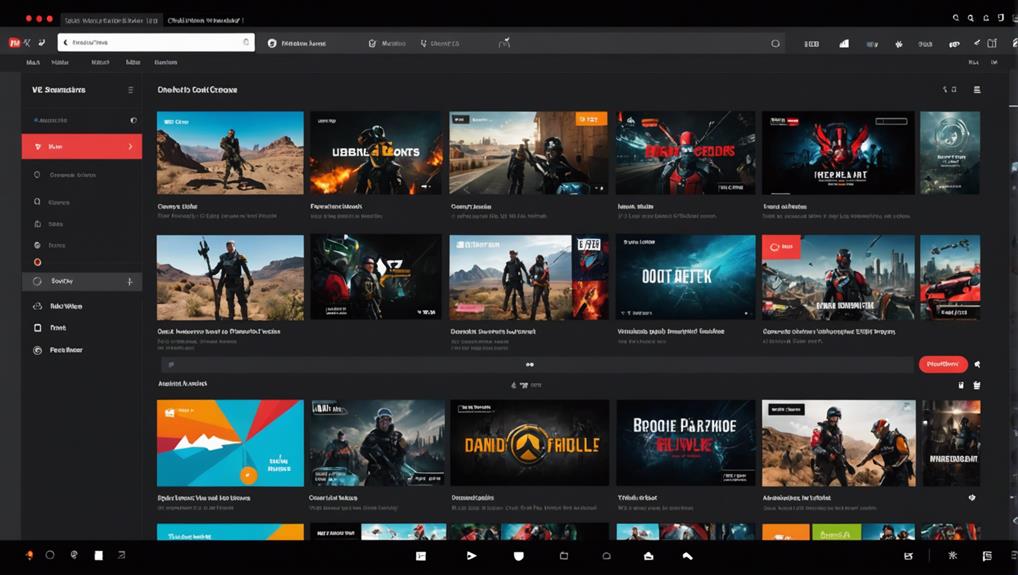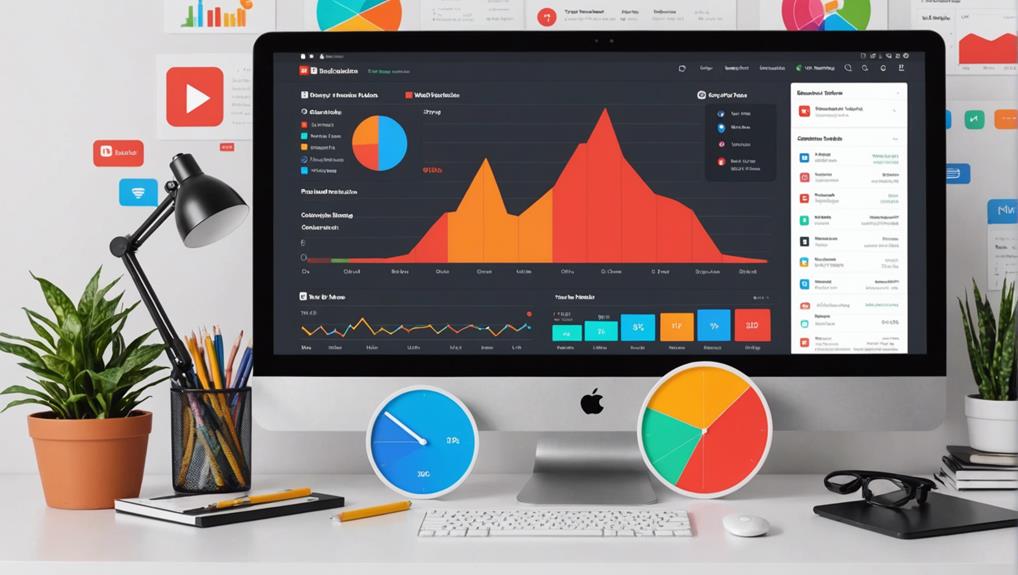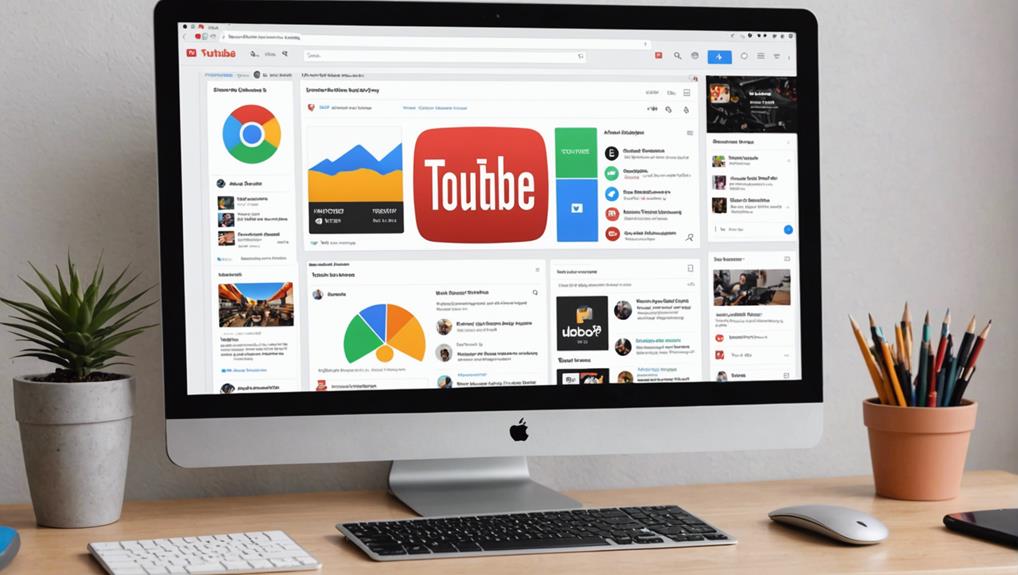Content creators seeking to optimize YouTube presence should leverage top SEO tools. TubeBuddy and VidIQ are essential for keyword research, offering analytics to track engagement metrics like watch time and retention. Ahrefs provides detailed keyword traffic insights, while Morningfame focuses on growth analytics. Social Blade tracks subscriber growth trends, assisting in strategic adjustments. Tools such as Canva facilitate content design with customizable templates. Each tool enhances content discoverability and viewer engagement, presenting an all-encompassing approach for YouTube strategy development. Exploring these resources will equip creators with potent strategies to dominate the competitive YouTube landscape.
Key Takeaways
- TubeBuddy offers keyword research, competitor analysis, and thumbnail design tools tailored for YouTube content creators.
- VidIQ provides comprehensive keyword research and competitor performance analysis to optimize video content and SEO strategies.
- Ahrefs delivers in-depth insights into keyword traffic, search volume, and difficulty for effective content planning.
- Morningfame focuses on analytics and performance tracking to support channel growth and strategy refinement.
- Social Blade tracks channel statistics, offering insights into subscriber growth and engagement trends.
Understanding YouTube SEO
In the dynamic landscape of digital content, understanding YouTube SEO is frequently essential for content creators aiming to maximize their video visibility and engagement. With over 500 hours of video uploaded every minute, effective YouTube SEO becomes indispensable. Central to this is keyword research, which involves analyzing search queries to align video content with audience interests. By conducting thorough keyword research, creators can enhance video optimization and improve visibility in search results.
The YouTube algorithm, a sophisticated mechanism, prioritizes videos using several factors, including engagement metrics such as watch time and click-through rates. Analyzing search volume and performance insights can guide creators in refining their content strategy to optimize their videos for better reach. Engaging content that retains viewers is not only favored by the algorithm but also important for sustaining viewer loyalty and boosting organic traffic.
In a platform where YouTube is the second-largest search engine globally, understanding the intricacies of SEO is essential. By focusing on video optimization and effectively utilizing engagement metrics, content creators can enhance their visibility and stand out in a competitive digital environment.
A strategic approach to YouTube SEO can greatly raise content discoverability and viewer engagement.
Essential YouTube SEO Tools
How can content creators effectively navigate the complex landscape of YouTube SEO to guarantee their videos gain maximum visibility? The answer lies in leveraging a suite of essential YouTube SEO tools designed for keyword research, video optimization, and channel growth.
TubeBuddy stands out with its extensive toolkit, offering keyword research tools and competitor analysis that empower creators to refine their strategies for enhanced search rankings and visibility. Its video optimization features further assure that content is primed for discovery.
VidIQ complements this with robust keyword research capabilities and a video scorecard, enabling creators to evaluate and improve their video optimization status. This tool is vital for identifying areas that require attention for better engagement and reach.
For those focused on in-depth keyword traffic insights, Ahrefs provides valuable data, making it ideal for refining YouTube SEO strategies.
Morningfame aids creators by focusing on growth analytics and tracking video performance metrics over time, allowing for informed adjustments based on data-driven insights.
Meanwhile, Social Blade offers social media insights and tracks channel statistics, presenting benchmarks for channel growth and performance evaluation.
These tools collectively equip content creators to excel in the competitive YouTube landscape.
Advanced Keyword Research
Frequently, the success of a YouTube channel hinges on the strategic implementation of advanced keyword research techniques. Utilizing advanced keyword research tools, such as Ahrefs and VidIQ, provides content creators with vital data including search volume and keyword difficulty. These tools are instrumental in identifying high-potential keywords that can greatly enhance video visibility and engagement.
Incorporating TubeBuddy’s Keyword Explorer into a creator’s toolkit offers the ability to unearth relevant long-tail keywords. These keywords are essential as they often present lower competition and yield higher engagement, making them a strategic choice for content optimization.
In addition, Keyword Tool provides valuable insights by suggesting terms based on trending search queries, allowing creators to align their content with popular topics.
Real-time trend tracking features, available in platforms like YTCockpit, guarantee that a creator’s content remains timely and discoverable by monitoring emerging keywords. This proactive approach helps maintain relevance in a rapidly evolving digital landscape.
While competitor analysis tools like those in Tubics serve different purposes, they complement keyword strategies by identifying successful tactics used by other channels. Collectively, these techniques and tools provide a solid foundation for effective YouTube keyword research.
Competitor Analysis Strategies
Competitor analysis is a critical strategy for content creators seeking to optimize their YouTube presence, involving the systematic examination of rival channels to identify successful content and engagement tactics.
Utilizing tools such as TubeBuddy and VidIQ, creators can decode competitor keywords, evaluate performance metrics, and benchmark their own strategies against industry leaders.
Analyzing Rival Channels
A content creator’s strategic edge often lies in their ability to effectively analyze rival channels, leveraging insights to refine their own video production and marketing efforts. Through YouTube SEO, creators employ competitor analysis to extract actionable insights on video performance and keyword usage, essential for maximizing video visibility. By utilizing tools such as VidIQ and TubeBuddy, creators can dissect engagement metrics, identify content gaps, and benchmark their channel performance against industry leaders.
| Tool | Key Feature | Benefit |
|---|---|---|
| VidIQ | Keyword Insights | Enhances video visibility |
| TubeBuddy | Competitor Analysis | Identifies engagement metrics |
| VidIQ | Video Performance Tracking | Benchmarks channel performance |
| TubeBuddy | Ideal Posting Time | Boosts audience engagement |
| VidIQ | Content Gap Identification | Addresses audience needs |
Analyzing rival channels through these tools allows creators to discover high-potential keywords by examining competitor tags and descriptions. Understanding the growth trends and subscriber counts of competitors provides benchmarks that inform strategic adjustments. Additionally, identifying content gaps in rival offerings enables creators to tailor content that addresses unmet audience needs, potentially increasing viewership and subscriber growth. Such data-driven, analytical approaches to competitor analysis are invaluable for content creators aiming to enhance their YouTube SEO strategy and solidify their position in the digital landscape.
Decoding Competitor Keywords
When dissecting a competitor’s keyword strategy, the insights gained can be pivotal in sculpting a robust content plan that enhances search visibility and audience reach.
Competitor keyword analysis is a cornerstone of effective YouTube SEO, enabling creators to identify which keywords successful channels in their niche leverage for optimizing video content. Tools like TubeRanker and VidIQ are invaluable in extracting competitor tags and keywords, offering a window into strategies that can be adapted to improve your own video performance.
Analyzing search volume and keyword difficulty through platforms such as Ahrefs and SEMrush helps creators pinpoint keywords that strike a balance between competitiveness and potential traffic.
Understanding these metrics allows for a more informed selection of keywords, ensuring that the content strategy is both thorough and targeted. Regular monitoring of traffic sources and competitor performance not only keeps creators attuned to trends but also reveals content gaps and opportunities for targeting underserved topics.
Benchmarking Content Strategies
Effective benchmarking of content strategies is vital for YouTube creators aiming to enhance their channel’s performance and competitive edge. Leveraging competitor analysis allows creators to dissect performance metrics of leading channels within their niche, offering a data-driven approach to refining their own YouTube SEO strategies. Tools such as VidIQ and TubeBuddy are instrumental, providing insights into competitors’ keywords, tags, and engagement rates, which can be significant in tailoring SEO strategy and improving video performance.
Analyzing video elements like titles, descriptions, and thumbnails reveals emerging trends and practices that boost engagement rates and click-through rates. Such insights are essential for developing content strategies that resonate with target audiences.
Additionally, understanding competitors’ audience demographics and behavior patterns offers valuable guidance on crafting content that aligns with viewer preferences, ultimately enhancing watch time and subscriber growth.
Regularly benchmarking against competitors’ performance metrics, including watch time and audience retention, guarantees that content strategies remain dynamic and responsive to market shifts. By systematically evaluating these factors, creators can optimize their content strategies, enhancing their channel’s visibility and fostering sustained engagement.
Consistent competitor analysis not only improves current content but also informs future strategic planning, securing long-term success in the YouTube ecosystem.
Video Performance Metrics
Understanding video performance metrics is essential for content creators working to optimize their presence on YouTube. Analyzing key indicators such as watch time, views, engagement rate, and audience retention provides valuable insights into the effectiveness of video content.
Watch time, a critical component of YouTube optimization, sheds light on viewer engagement duration, directly influencing the platform’s algorithmic ranking. High watch time signifies that content is resonating well, thereby improving visibility.
Views serve as a fundamental metric reflecting a video’s reach and popularity among audiences. They are a straightforward measure of how often content is being consumed.
Meanwhile, engagement rate, calculated through interactions like likes, comments, and shares, offers insights into viewer interaction and satisfaction, affecting search result visibility and recommendation algorithms.
Audience retention metrics further enhance channel management by revealing the average percentage of the video watched. This data helps pinpoint engaging segments and areas needing improvement, aiding creators in refining their content strategy.
Tracking these metrics allows for a thorough evaluation of video performance, highlighting valuable keywords and strategies that enhance both content quality and audience connection. Overall, these insights are indispensable for refining YouTube channel management and achieving sustained growth.
Tools for Content Design
Analyzing video performance metrics equips content creators with the insights necessary to refine their strategies, but leveraging the right tools for content design is equally integral to enhancing YouTube success.
Canva stands out among design tools with its extensive library of customizable templates, specifically crafted for YouTube thumbnails and channel art. By utilizing Canva‘s resources, content creators can boost click-through rates by up to 30%, greatly impacting video performance.
Adobe After Effects is essential for producing high-quality visual content. As an industry-standard software, it provides creators with the ability to develop sophisticated visual effects and motion graphics, elevating the overall quality of YouTube videos.
Meanwhile, Davinci Resolve offers robust video editing and color correction capabilities, ideal for creators seeking meticulous control over their video marketing aesthetics.
Thumbnail generators, such as those offered by TubeBuddy, enhance video performance by suggesting designs that resonate with viewers. These tools streamline the creation process, ensuring visual content aligns with audience preferences.
Additionally, Google Trends serves as a critical tool for content creators, offering insights into trending topics and seasonal patterns. This data-driven approach allows creators to design relevant visual content that captures peak viewer interest, optimizing their YouTube strategy.
Enhancing Audience Engagement
Attracting and retaining viewers hinges on strategic audience engagement techniques, a fundamental component for amplifying YouTube success. Implementing engaging video titles and descriptions can boost click-through rates by up to 30%, directly impacting YouTube SEO and audience engagement.
Optimized tags are essential for aligning content with YouTube’s algorithm, enhancing categorization, and increasing viewer retention by ensuring your videos are suggested to the most relevant audiences.
Interactive elements such as polls and end screens greatly enhance viewer engagement, directly influencing watch times—a critical metric for YouTube’s recommendation system. Consistent posting, coupled with responsive interaction in the comments section, fosters a robust community, encouraging subscribers to return and engage with future content, thereby improving channel performance.
Utilizing YouTube Analytics is key in refining your content strategy. By analyzing audience demographics and viewing habits, creators can tailor content to align with viewer interests, driving more views and improving engagement.
These data-driven insights are indispensable for optimizing video titles and tags, ensuring sustained audience retention and increased channel performance. Collectively, these strategies form the backbone of a successful YouTube SEO approach, essential for driving more views and long-term growth.
Managing Channel Growth
Effectively managing channel growth on YouTube hinges on strategic use of advanced tools like TubeBuddy and VidIQ, which offer critical insights into keyword optimization and competitor analysis.
These YouTube SEO Tools are essential for improving visibility and audience engagement by enhancing video rankings. Leveraging these platforms, content creators can refine their content strategies by identifying high-performing keywords and optimizing their videos for better searchability. This process not only boosts video performance but also guarantees sustainable channel growth.
Conducting regular channel audits using TubeRanker is pivotal in identifying performance gaps. By analyzing key metrics such as watch time and audience retention, creators can make informed, data-driven adjustments to their content strategies.
Additionally, analytics tools like Social Blade provide valuable insights into trends in subscriber growth and video performance over time, allowing for strategic planning and optimization of SEO techniques, such as enhancing video titles, descriptions, and tags.
Frequently Asked Questions
Which SEO Tool Is Best for Youtube?
When determining the best SEO tool for YouTube, consider features like YouTube keywords, video tags, audience engagement tracking, and competitor analysis. TubeBuddy and VidIQ excel in metadata optimization and analytics tracking, enhancing content strategy, thumbnail design, and viewer retention.
What Is the Most Popular Extension for Youtube SEO?
The most popular extension for YouTube SEO is TubeBuddy. It excels in YouTube Keywords, Video Tags, Title Optimization, Thumbnail Design, and Competitor Research, providing Analytics Insights, Trend Analysis, and tools to enhance Audience Engagement and Channel Branding.
How Do I Optimize My SEO on Youtube?
To optimize YouTube SEO, conduct keyword research, enhance title optimization, and refine description writing. Utilize video tags, thumbnail design, and playlist organization. Focus on audience engagement through analytics tracking and competitor analysis to improve content strategy.
Does SEO Really Work for Youtube?
SEO is effective for YouTube, enhancing content visibility and audience engagement through YouTube algorithms. By conducting keyword research, optimizing metadata, analyzing competition, and monitoring search trends, creators can improve video ranking, viewer retention, and channel growth.
Conclusion
In summary, employing YouTube SEO tools is vital for content creators aiming to optimize their digital presence. Utilizing advanced keyword research and competitor analysis strategies enhances visibility and competitiveness. Monitoring video performance metrics provides insights for continual improvement. Tools dedicated to content design and audience engagement are critical for maintaining viewer interest and boosting interaction. Effective management of channel growth guarantees sustained success. The integration of these tools into a cohesive strategy is fundamental for maximizing YouTube channel potential.




